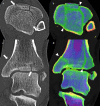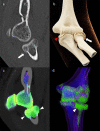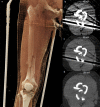Dual-energy CT characterization of winter sports injuries
- PMID: 31573325
- PMCID: PMC7055449
- DOI: 10.1259/bjr.20190620
Dual-energy CT characterization of winter sports injuries
Abstract
CT is a readily available imaging modality for cross-sectional characterization of acute musculoskeletal injuries in trauma. Dual-energy CT provides several additional benefits over conventional CT, namely assessment for bone marrow edema, metal artifact reduction, and enhanced assessment of ligamentous injuries. Winter sports such as skiing, snowboarding, and skating can result in high speed and high energy injury mechanisms; dual-energy CT is well suited for the characterization of those injuries.
Figures








Similar articles
-
Self assessment in trauma & orthopaedics II.J R Army Med Corps. 2008 Dec;154(4):247-53. doi: 10.1136/jramc-154-04-09. J R Army Med Corps. 2008. PMID: 19496371 No abstract available.
-
Color-coded virtual non-calcium dual-energy CT for the depiction of bone marrow edema in patients with acute knee trauma: a multireader diagnostic accuracy study.Eur Radiol. 2020 Jan;30(1):141-150. doi: 10.1007/s00330-019-06304-7. Epub 2019 Jul 26. Eur Radiol. 2020. PMID: 31350586
-
Clinical Utility of Dual-Energy CT Analysis of Bone Marrow Edema in Acute Wrist Fractures.AJR Am J Roentgenol. 2018 Apr;210(4):842-847. doi: 10.2214/AJR.17.18673. Epub 2018 Feb 22. AJR Am J Roentgenol. 2018. PMID: 29470155
-
Clinical utility of virtual noncalcium dual-energy CT in imaging of the pelvis and hip.Skeletal Radiol. 2019 Dec;48(12):1833-1842. doi: 10.1007/s00256-019-03243-8. Epub 2019 May 30. Skeletal Radiol. 2019. PMID: 31147733 Review.
-
Essential facets of radiological diagnosis of extremity trauma.CRC Crit Rev Diagn Imaging. 1977 May;9(2):105-205. CRC Crit Rev Diagn Imaging. 1977. PMID: 18319 Review.
Cited by
-
Dual-Energy CT Arthrography: Advanced Muscolo-Skelatal Applications in Clinical Practice.Tomography. 2023 Aug 8;9(4):1471-1484. doi: 10.3390/tomography9040117. Tomography. 2023. PMID: 37624110 Free PMC article. Review.
-
The utility of virtual monochromatic dual-energy computed tomography (DECT) in meniscal imaging: a technical evaluation.Pol J Radiol. 2024 Jul 8;89:e324-e327. doi: 10.5114/pjr/187934. eCollection 2024. Pol J Radiol. 2024. PMID: 39139259 Free PMC article.
-
Reviewing Bone Marrow Edema in Athletes: A Difficult Diagnostic and Clinical Approach.Medicina (Kaunas). 2021 Oct 22;57(11):1143. doi: 10.3390/medicina57111143. Medicina (Kaunas). 2021. PMID: 34833361 Free PMC article. Review.
-
Identification of Non-Traumatic Bone Marrow Oedema: The Pearls and Pitfalls of Dual-Energy CT (DECT).Tomography. 2021 Aug 26;7(3):387-396. doi: 10.3390/tomography7030034. Tomography. 2021. PMID: 34449751 Free PMC article.
-
Imaging of osteoarthritis from the ankle through the midfoot.Skeletal Radiol. 2023 Nov;52(11):2239-2257. doi: 10.1007/s00256-023-04287-7. Epub 2023 Feb 4. Skeletal Radiol. 2023. PMID: 36737484 Free PMC article. Review.

